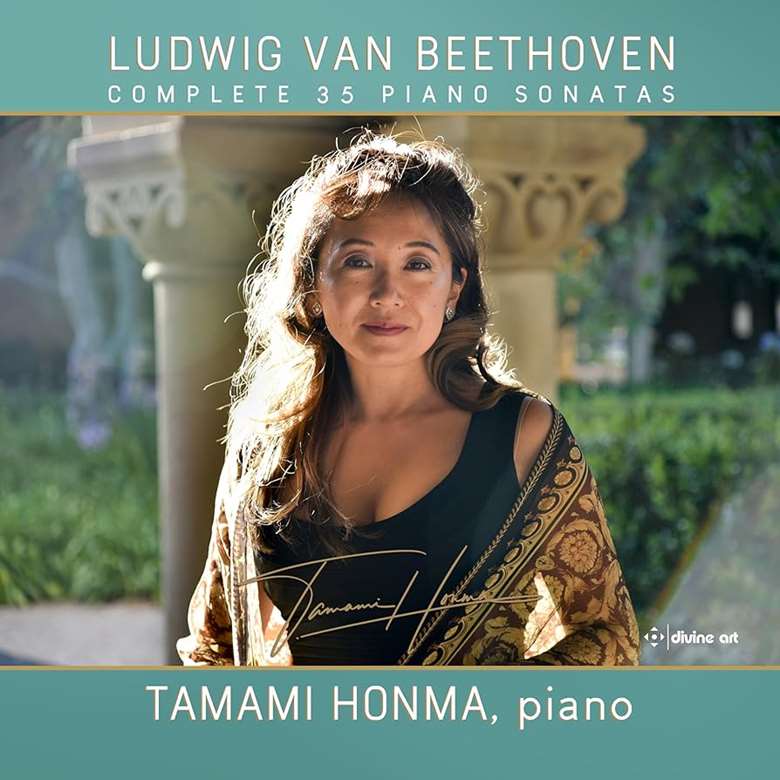Beethoven: Complete Piano Sonatas (Tamami Honma)
Guy Rickards
Friday, March 8, 2024
As a cycle this is rather good, and one I will return to often

I first encountered Tamami Honma’s playing in 2002 on a Métier CD accompanying the indefatigable Peter Sheppard Skærved in works by Rawsthorne and McCabe. Since then, her modest discography has traversed more McCabe (Second Concerto, solo pieces, and a duo programme with the composer), Rawsthorne’s complete piano output, Chopin’s concertos arranged as quintets, and Mozart violin-and-piano sonatas (with Howard Davis).
In February 2016 Honma embarked on the cycle of 32 piano sonatas as part of her ‘Beethoven Odyssey’, also taking in the 10 with violin, the five concertos, Choral Fantasy, and a staging of Fidelio with West Bay Opera. The present recordings, using her own Steinway B with its distinctive sonority, were made in Saratoga’s Cal Arte Studios between 2019 and 2023, and one can hear from the outset that this is music Honma has lived and breathed for many years. In her ‘Odyssey’ programmes, Honma played the two Op 49 sonatas from 1792 (pre-dating the official First Sonata of 1794) in numerical sequence between the Op 31 set and the Waldstein. Yet Op 49 provides a vital step in Beethoven’s early compositional evolution, especially when heard in the context of the three Kurfürst Sonatas (composed in his early teens for Maximilian Friedrich, the Prince-Elector of Cologne), which Honma, following the ABRSM critical edition of Barry Cooper, includes on her first disc, with Op 49 placed close to their proper chronological position, between Op 2 and Op 7. Hence she presents 35 sonatas (as with Brautigam on BIS), covering four decades of the composer’s life.
A bonus on the first disc is the Andante favori, originally written for the Waldstein but later replaced by the Introduzione that leads into the Waldstein’s glorious finale. Honma judges that finale (disc 7) just about perfectly, letting it sing as it should but with a keen eye for structure. Readers may know how much I esteem Paul Lewis’s Harmonia Mundi cycle (just the 32 numbered sonatas, not sequenced chronologically), but taken as a whole Honma’s accounts stand up well in comparison to his or Brautigam’s. Honma’s performances are often swift, especially in the outer movements, usually without sounding rushed (the pell-mell finale of Op 54 is an exception, the phrasing a touch awkward in places to my ear). The Tempest and Hunt sonatas (Op 31 Nos 2 and 3) are fine examples, Honma bringing out the drama as much as the lyricism of the keyboard-writing; the conclusion of the Hunt, for instance, is particularly satisfying.
So too is her way with, for instance, Op 7 in E flat major, Beethoven’s first big-boned sonata, or the over-familiar Appassionata (Op 53). Honma’s interpretative approach evolves as the cycle progresses, a measure of and reaction to the development in the composer’s piano-writing, from the Mozartian proportions of the early works to the more Romantic style that becomes more prominent from the Pathétique on. The Pathétique is rendered very well indeed, especially heard as part of the greater whole rather than as a stand-alone ‘pops’ number. So, too, the Moonlight and, initiating the magisterial sequence of the final 10 sonatas, the Appassionata: Honma, like Lewis, lets the music sing without any extraneous imposition of personality that has disfigured many an interpretation elsewhere.
For many, the acid test of any such Beethoven survey is the later sonatas, particularly the Hammerklavier and its three successors. Suffice it to say that the strengths of Honma’s interpretations of the earlier works persist to the end, whether in the lyrical warmth of Op 90’s finale or the stratospheric heights of the final three. Yes, there may be more sensational, spectacular or mesmerising renditions of individual works, but as a cycle this is rather good, and one I will return to often, as I have barely scratched its surface for this review. Divine Art’s sound is very natural, every note, chord and twang of Honma’s trusty instrument caught with unflinching clarity. If this set does yield to Harmonia Mundi’s warmly resonant recording for Lewis or BIS’s spotlit clarity for Brautigam, I rather like its unobtrusive intimacy, never detracting from the music itself and Honma’s consistently fine playing of it.
This article originally appeared in the Spring 2024 issue of International Piano. Never miss an issue – subscribe today









